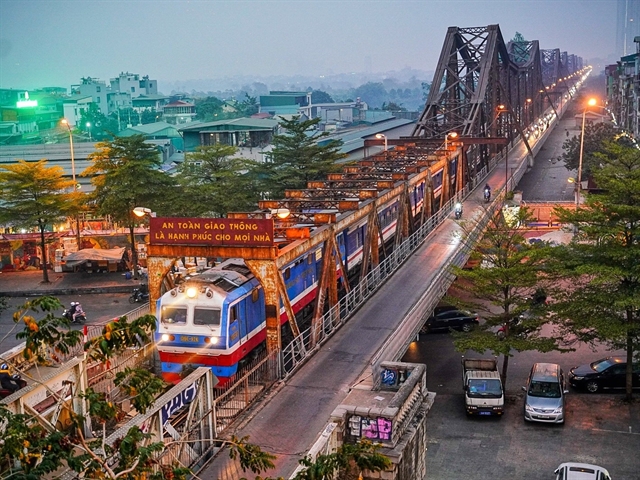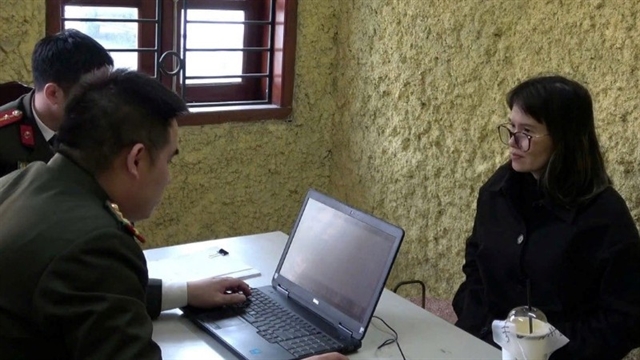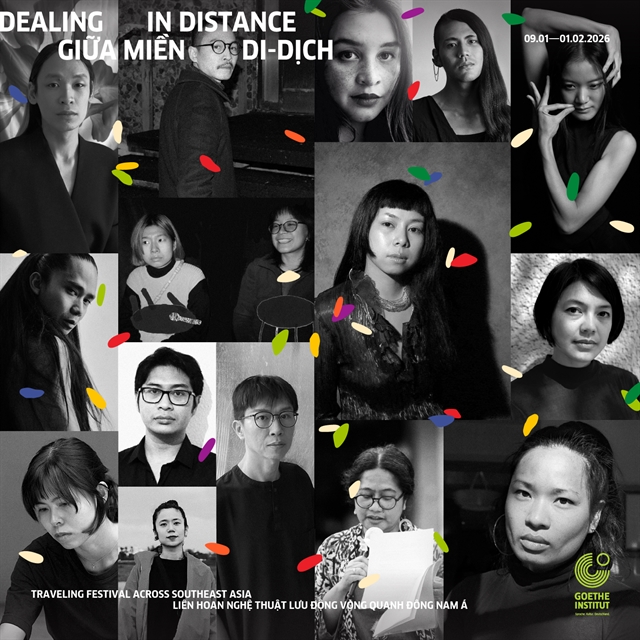 Features
Features

Glorious jade sceptres, precious terracotta mythical creatures and gigantic bronze drums are few among 300 artefacts being showcased in public for the first time.
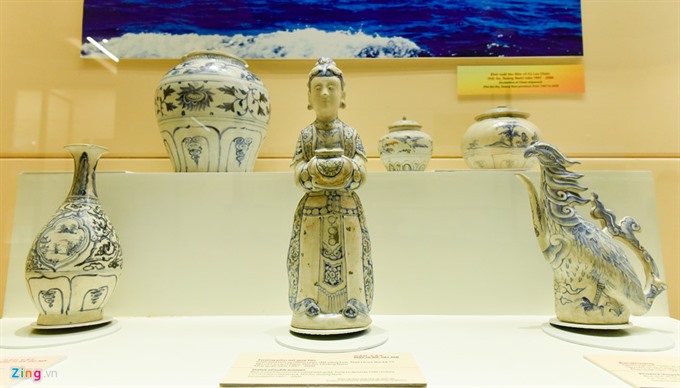 |
| Long history: Many ceramic objects found at a shipwreck in Cù Lao Chàm sea territory proved the exchange between Vietnamese and foreign traders. VNS Photo Đoàn Tùng |
by Đỗ Minh
Glorious jade sceptres, precious terracotta mythical creatures and gigantic bronze drums are few among 300 artefacts being showcased in public for the first time.
The exhibition, “Treasures of Vietnamese Archaeology”, which will remain open till the end of July at Hà Nội’s National Museum of History, displays these objects representing significant periods in national history. They are the result of many excavations by Vietnamese archaeologists and historians spanning more than 50 years.
“The exhibition displays the most beautiful, precious, rare and intact artefacts selected from numerous objects excavated from archaeological sites,” Nguyễn Văn Đoàn, vice director of the museum, said.
Magnificent past
The exhibition comprises collections of the National Museum of History and several museums nationwide, taking visitors back in time to three different periods in history.
Prehistoric artefacts include tools, stone jewellery and pottery discovered from sites across the country dating back to the first century.
 |
| Long ago: An artefact belonging to Óc Eo Culture (6th-7th centuries). VNS Photo Đoàn Tùng |
Also on display are antiques from the Champa Kingdom (192-1471) and Mỹ Sơn World Cultural Heritage, remnants of Óc Eo-Funan Culture in the Mekong Delta from the first to the seventh century.
Prominent among the exhibits is a boat tomb found in 2000 in Châu Can Commune in Phú Xuyên District on the outskirts of Hà Nội. Scientists identified the tomb dating to 3000BC.
"Boat tomb was one of the burial practices of Đông Sơn culture. Many boat tombs have been discovered among the Đông Sơn relics up to now, giving archaeologists compelling reasons to study the famous culture," Đoàn said.
“During the process of researching the burial practices, we realised that artefacts found in the tomb have different dates. It’s easy to understand. Perhaps the boat belonged to a man and when he died, his family turned it into a coffin,” Đoàn said.
“The dates in the boats and coffins, along with inhumation utensils, are several centuries apart because the boat was used by one generation before serving as a coffin in another generation.”
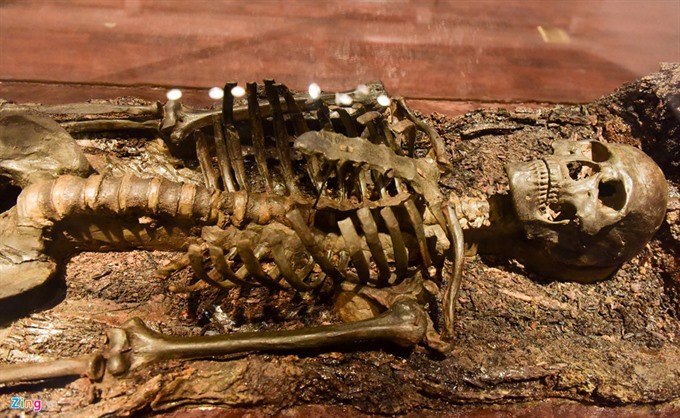 |
| Ancient ancestors: A skeleton inside a Châu Can boat tomb is one among the most special artefacts displayed at the exhibition. VNS Photo Đoàn Tùng |
Unfolding secrets
Archaeologist Trịnh Sinh, head of the team that discovered the Châu Can boat tomb, said the discovery revealed a secret hidden for thousands of years.
“Many utensils were buried together with the dead but it’s interesting to learn that all of them were damaged on purpose,” Sinh said.
“For example, we found a spear cut into three pieces, a bronze drum with a hole and jars smashed into little bits. We think people deliberately did that to differentiate the belongings of the dead. Like the difference between yin and yang, of the living world and afterlife,” Sinh said.
Kevin Levon, a Frenchman who works as an art designer in Việt Nam, considers the skeleton in the Châu Can boat tomb the most impressive find.
“It is interesting to see that it is well preserved even after thousands of years,” he said.
“I am happy that these artefacts are on public display. We now have a chance to better understand Vietnamese history, skills of craftsmen in the old days and people’s customs in the past. The exhibits I see today will be inspiration for me to create art for sure,” he added.
The most significant boat tomb of Đông Sơn culture that was discovered in Việt Khê Village, Thuy Nguyen District on the outskirts of Hải Phòng City in 1961. This is among the five tombs discovered, thanks to its good preservation, which saved more than 100 inhumation utensils.
This is the largest boat tomb belonging to Đông Sơn culture and was made from a tree trunk with an extruded core, having the shape of a single boat with two ends, with one end larger than the other. The coffin has a round cross section with two parts. The body and cover measure 4.76m in length and 0.6m in height. The inner side of the coffin is smooth, while the outer side was left raw, with only the rind removed.
This boat tomb also had the largest amount of inhumation utensils intact, with more than 100 units made of bronze, lacquer, wood, bamboo and leather. The utensils were arranged according to their size: relatively large ones as drum, vessel, vase and bronze chalice bowl were placed at the larger end of the coffin, while the smaller end had tools and armaments as axe and knife. In the middle were placed a hand bell, tray, chalice and a piece of lacquered leather. On the sides of the coffin were placed spears with handles and wooden paddles. Interlacements and decayed tissues were placed at the bottom.
“The utensils, besides belonging to Đông Sơn culture, also signify cultural interchange,” said Đoàn.
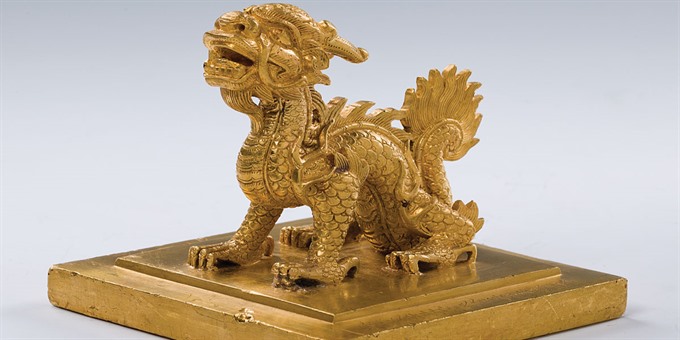 |
| Valuable: A golden seal of the Nguyễn Dynasty displayed at the exhibition. VNS Photo Đoàn Tùng |
The extremely valuable exhibits include a dragon-shaped seal made of pure gold, weighing 4.7kg.
The seal is being kept in a safe. Heavy seals symbolised the power of Vietnamese emperors. At least 100 such seals were produced during the Nguyễn Dynasty (1802-1945).
From Germany to Việt Nam
All of the artefacts were displayed in Germany before the exhibition in Hà Nội. The archaeological collection was showcased in three German museums -- the LWL Herne Museum for Archaeology, the Chemnitz National Archaeological Museum in Chemnitz and the Reiss-Engelhorn Museum in Mannheim from October 2016 to January this year.
Đoàn said the display was part of a programme promoting Vietnamese culture and history in the European country, in cooperation with Vietnamese and German governments.
The German museums and foreign ministry spent years negotiating the terms of the exhibition with the Vietnamese authorities.
The exhibition offered insights into Viet Nam’s past, which is little known to Europeans.
Visitors to the exhibition in Viet Nam will go on a fascinating journey through more than 10,000 years of Việt Nam’s cultural history, starting from the Stone Age to the present.
“The exhibition (in Germany), jointly held by German and Vietnamese governments, served the foundation for the ongoing exhibition in Hà Nội. We have a chance to learn from German specialists the ways to preserve and display the exhibits,” Đoàn said.
“The treasures weighing hundreds of tonnes, including those that are very special, such as the gold dragon-shaped seal and the boat tombs, were stored in tin boxes and transported by air,” he added.
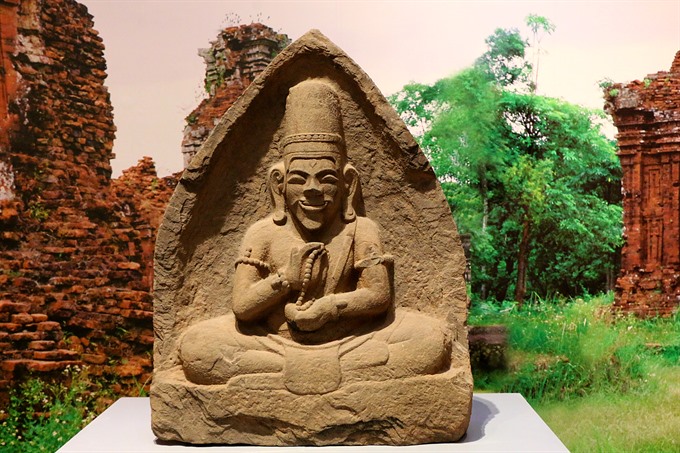 |
| Not in ruins: A statue belonging to Óc Eo Culture found at Mỹ Sơn Sanctuary. VNS Photo Đoàn Tùng |
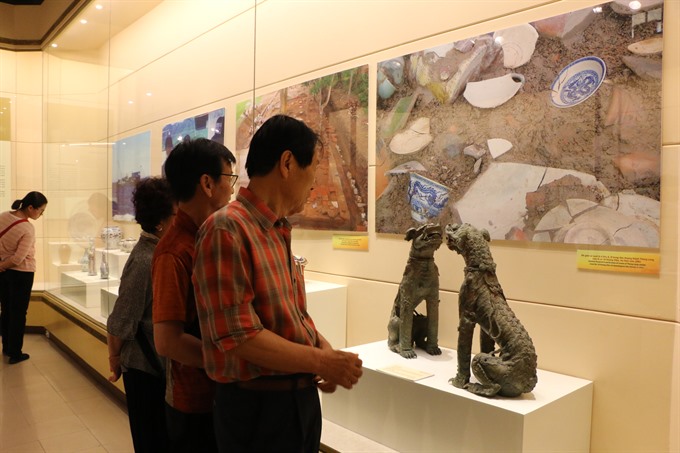 |
| Take a look: Visitors contemplate the artefacts at the exhibition to learn about different historical periods. VNS Photo Đoàn Tùng |
 |
| Rising: Phoenix-shaped decorative object found in the archaeological site of Thăng Long Royal Citadel, Hà Nội. VNS Photo Đoàn Tùng |
Andreas Reinecke was the chief curator of the exhibition in Germany. He led a group of scientists who supported the Vietnamese side with their technology and experience in transporting, preserving and displaying the artefacts in Germany and Hà Nội. Reinecke has a special affinity towards Việt Nam as he followed the wars in the country and its consequences closely since the 1970s.
“During my studies, I had many amiable fellow students from Việt Nam around me who were studying history or ‘archival science’. All that made me curious about the country’s history. Besides, Southeast Asia in the 1970s was believed to be a region of early neolithisation, particularly early Bronze Age. That was not subsequently borne out, but to this day there is a tremendous appeal of working in a region that still has huge research gaps and whose culture was so different from European prehistory,” Reinecke said.
“The exhibition in Germany attracted thousands of visitors, including many Vietnamese overseas, because it gave a rare opportunity to learn about Vietnamese prehistory, which is not popular in Europe,” he told Việt Nam News.
"No country in Southeast Asia has carried out so many excavations and built so many museums as Việt Nam has," he added.
Reinecke started working on the exhibition of Vietnamese archaeology since 2012. In the blog of Herne Museum for Archaeology, he said one of the exciting things during the years of preparation was working at over 30 provincial museums with support from Việt Nam’s Ministry of Culture.
"It was a unique opportunity to get to know about the museums’ storerooms, my colleagues and rare finds. One of the ’downs’ was definitely the pressure during the last eight months, partly due to the complicated negotiations concerning the participating museums, exhibits and transportation variants. That was a hard nut to crack; I literally broke a tooth over it,” Reinecke said.
He added that there were plenty of exciting exhibits, and if one had to choose, the most profound impression was of the Việt Khê tomb.
“Two thousand years ago, a segment of a dugout canoe was converted into a coffin and fitted with nearly 100 bronze and other burial gifts,” he said.
Sparking new debates
Bùi Chí Hoàng from the Việt Nam Academy of Social Sciences said many exhibits should be researched further to build a dossier to facilitate their recognition as national treasure. Hoàng had joined Vietnamese and German experts to select the artefacts for the Việt Nam Archaeology exhibition in Germany.
According to him, the Châu Can boat tomb, gold dragon-shaped seal of the Nguyễn Dynasty and a gold linga found in Cát Tiên archaeological site in Lam Dong Province are worthy to be recognised as national treasures.
“The linga in Cát Tiên is the only one made of gold found until now,” Hoàng said.
He, however, expressed concern in researching and preserving the artefacts to develop their values. “We still lack financial and technological conditions,” he said.
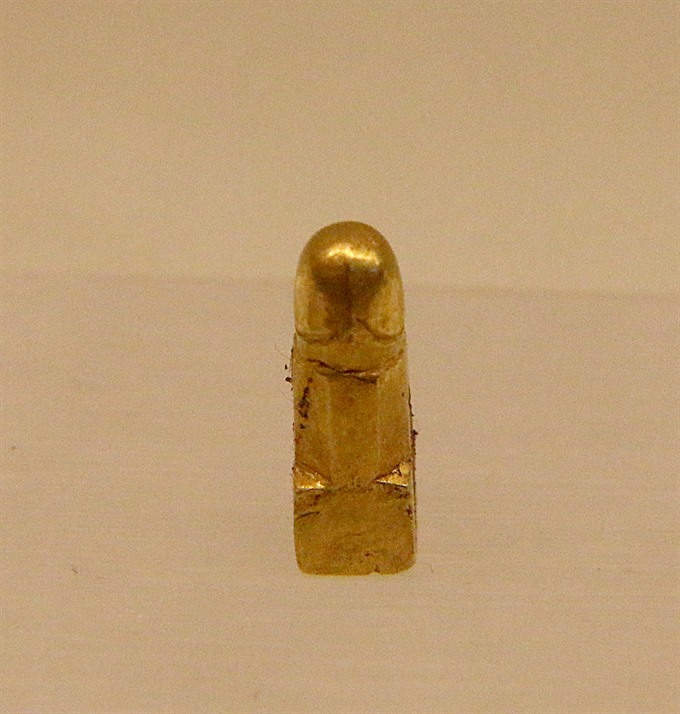 |
| Delicate: A gold linga (Champa Culture) found in Cát Tiên archaeological site is worthy of its recognition as a national treasure. VNS Photo Đoàn Tùng |
Reinecke said the main difference between Vietnamese and German archaeology might be the way in which experts handled the tasks after excavation: restoration, analysis, storage and publication of the findings.
“In the next few decades, a great deal must change in Việt Nam,” he said. “That will require new ways of working in many different aspects. Our hope lies with the young generation of archaeologists in Việt Nam.”
German experts have compiled a 600-page catalogue to feature the Vietnamese exhibits in Germany. This is the first compendium of Vietnamese archaeology and history in the German language. "It will probably be the only one of its kind for the next 20 years," Reinecke said.
“The exhibits section especially contains a great deal of new materials that cannot be found in Vietnamese or English literature and is bound to spark some exciting debates in future,” he said.
“We wanted exhibits ‘with soul’, for which it was important to know how they were discovered, where, by whom and in what context. This gives the exhibits informational value that goes beyond individual objects and makes it possible to tell stories. Our goal was, among other things, to focus on the overall archaeological work in Việt Nam and spur further research with new interpretations and datings,” Reinecke said. VNS

